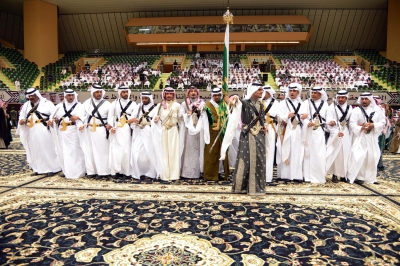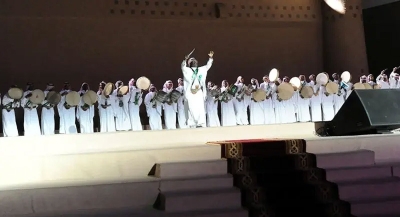
The Saudi Ardah Rows refer to the arrangement and alignment of performers in a specific format. They consist of two opposing rows with participants holding hands, surrounded by drummers and sword bearers. The Saudi Ardah includes the following elements: the banner (flag), drums, weapons and swords, attire, and the poet.
Formation of the Saudi Ardah rows
The Saudi Ardah rows consist of two opposing lines of men, each holding the hand of the next. Each row begins chanting lines of the poem according to its poetic meter. The recital of these lines follows a unified system as follows: one row recites a verse or line of the poem, then leans to the right and left without dancing, a movement known as "Naz." Next, the poet or instructor recites the second line or verse of the poem. Drums are then played, and during the Ardah performance, the rows sway right and left, bending the right knee when leaning right and the left knee when leaning left.
The Saudi Ardah dance
Performers of the Saudi Ardah hold swords in their hands during the dance, performing several movements in unison, such as continuously raising the sword upward and lowering it downward, or resting it on the shoulder. Traditionally, when reciting poetry that expresses pride in the homeland and the leader, the swords are raised high.
Ardah in Saudi culture
The Saudi Ardah is a part of the Kingdom's cultural heritage, and it is performed as a national symbol during national occasions, celebrations, and holidays. Historically, the Ardah was originally held before heading into battles and wars to inspire enthusiasm among soldiers and ensure their readiness.
Related quizzes
Related articles


